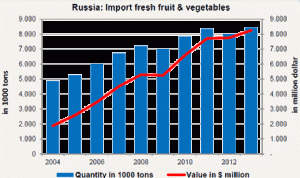The Russian Federation exported 396,700 MT of vegetables in Q1 2020. This is 20.3% more than during the same period in 2019. In volume terms, exports increased by 11.6% to $98.3 million.
During the first quarter of 2020, vegetables were exported from Russia to 64 countries. The major countries of destination were Ukraine, Pakistan, Azerbaijan, and Turkey.
A large share of the export was peas. In January-March 2020, 125,400 MT (+5.1%) of peas, worth $31.7 million (+8.2%) was exported. Pakistan, Italy, Bangladesh, and Nepal accounted for a significant share of supplies. Potato export increased to 125,000 MT worth $14.4 million (2.2 times up). The main countries of destination were Ukraine, Azerbaijan, Moldova, and Turkmenistan.
Chickpea exports came to 78,600 MT (+6.4%) worth $28.4 million (-0.4%). Most of the volume was shipped to Pakistan and Turkey. Onions and garlic exports came to 22,900 MT (-27.8%) worth $3.4 million (-35.8%), mostly to Iraq, Ukraine, Georgia, Azerbaijan, and Moldova.
Cucumber export increased by 3.5 times in volume terms to 5,200 MT by 6.8 times in value terms to $4.1 million. Cucumbers were mostly designated for Belarus and Ukraine.
Exports to Ukraine increased by 87% up to 73,500 MT in volume terms and by 67.9% up to $9.4 million in value terms. Most of the shipments were potatoes.
